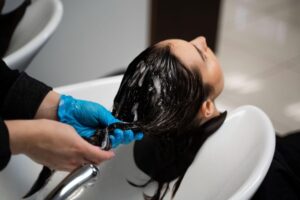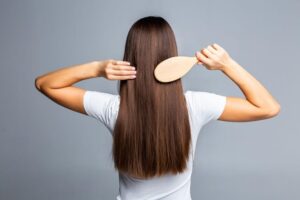Last updated on September 26th, 2024 at 04:18 pm
Keratin is a naturally occurring protein in our hair, responsible for its strength and structure. Keratin hair treatment involves applying a specialized formula that usually contains a high concentration of keratin along with other ingredients. This formula is then sealed into the hair using heat, typically from a flat iron.
The treatment aims to infuse the hair with keratin, making it smoother, more manageable, and less prone to frizz. In the realm of Benefits of Keratin Treatments of hair care, the term “keratin treatment” has gained significant prominence recently. These treatments, often referred to as “keratin hair treatment,” are designed to transform frizzy, unruly hair into smoother, shinier locks. They have garnered a reputation for being a game-changer in the world of hair care.
Keratin Treatment at Home
Keratin Treatment at Home typically involves using a kit that includes a keratin-infused formula, along with the necessary tools and instructions for application. These kits cater to individuals who desire smoother, more manageable hair without the expense of salon treatments.
Benefits of Keratin Treatment at Home
The benefits of Keratin Treatment at Home are as follows:
- Convenience: At-home treatments offer the flexibility of scheduling the treatment at your convenience. You won’t need to make an appointment or travel to a salon.
- Cost Savings: At-home kits are generally more affordable than professional salon treatments, making them an appealing option for those on a budget.
- Privacy: Some individuals prefer the privacy of their own space when undergoing a beauty treatment, making at-home options more appealing.

Tips for a Successful Keratin Treatment at Home
The important tips and tricks for a Keratin Treatment at Home are as follows:
- Research Products: Choose a reputable and well-reviewed keratin treatment at-home kit. Look for formaldehyde-free products that contain quality ingredients to ensure the best results and minimize potential side effects.
- Read Instructions Thoroughly: Carefully read and understand the instructions provided with the kit.
- Patch Test: Before applying the treatment to your entire head of hair, perform a patch test on a small, hidden section to check for any adverse reactions or allergies.
- Gather Tools: Make sure you have all the tools you’ll need, including gloves, a comb, a flat iron, and clips.
- Preparation is Key: Shampoo your hair with a clarifying shampoo to remove any buildup and open the hair cuticles, allowing the treatment to penetrate effectively. Towel-dry your hair before applying the treatment.
- Application Technique: Divide your hair into sections and apply the treatment evenly, focusing on the mid-lengths to ends. Avoid applying the treatment directly to the scalp to prevent irritation.
- Follow Processing Time: Stick to the recommended processing time mentioned in the instructions. Overexposure to the treatment can lead to damage or undesirable results.
- Rinse and Seal: After processing, rinse the treatment thoroughly with water. Follow up by sealing the treatment into the hair using a flat iron set to the appropriate temperature.
- Post-Treatment Care: Be mindful of post-treatment care instructions, which may include using sulfate-free shampoos and conditioners to extend the longevity of the treatment.
> Consult a doctor and Order Medicine Online
Keratin Considerations and Cautions
- Skill Level: Applying a keratin treatment at home requires a certain level of skill and attention to detail.
- Results May Vary: The results of at-home treatments may not be as consistent or as long-lasting as those from professional salon treatments. Be prepared for some variation in outcomes.
- Potential Challenges: Achieving salon-quality results at home might be challenging, especially if you’re new to the process. Professional stylists have experience and training that can be difficult to replicate at home.
Keratin Treatment At Home offers a convenient and cost-effective way to achieve smoother, more manageable hair. By researching products, following instructions meticulously, and being mindful of potential challenges, you can enhance your chances of a successful keratin treatment at home experience.
However, if you’re seeking more complex results or have concerns about the application process, consulting a professional stylist might be a wise choice to ensure the best outcome for your hair.
Is Keratin Hair Treatment Good for Hair?
Keratin Hair treatment can indeed offer positive results, especially for those with frizzy or unmanageable hair. However, they might not be suitable for everyone. People with naturally straight hair might not experience as dramatic a transformation as those with curly or wavy hair.
Benefits of Keratin Treatment
Keratin treatments have emerged as a transformative solution in the realm of hair care, promising to bestow a range of benefits upon those seeking to tame frizz, enhance manageability, and achieve sleek, glossy locks. These treatments, revered for their ability to revolutionize hair texture, come with a host of advantages that have captured the attention of hair enthusiasts and professionals alike.
- Frizz Control and Smoothing:
One of the most celebrated benefits of keratin treatments is their remarkable frizz-controlling prowess. For individuals grappling with unmanageable, frizzy hair, these treatments can work wonders. The infusion of keratin into the hair shaft helps to seal the cuticles, creating a smoother surface that resists humidity-induced frizz. This results in effortlessly sleek and polished hair, even in challenging weather conditions.

- Enhanced Manageability:
Keratin treatments bring about a marked improvement in hair manageability. Treated hair becomes more pliable, making styling a breeze. The reduced frizz and increased flexibility mean less time spent taming your locks and more time enjoying your preferred style.
- Reduced Styling Time and Heat Damage:
With the smoothing effect and increased manageability, you’ll find that your hairstyling routine becomes more efficient. The need for extensive heat styling tools decreases, leading to a reduction in heat-related damage. This can contribute to the overall health and vitality of your hair, as it’s exposed to less stress from heat.
- Long-Lasting Results:
A significant allure of keratin treatments is their longevity. Depending on factors such as hair type and maintenance routine, the results of a keratin treatment can last for several weeks. This extended period of sleek, shiny hair eliminates the need for daily styling struggles and frequent touch-ups.
- Restoration of Hair Health:
Keratin, being a natural protein found in hair, plays a pivotal role in maintaining hair health and strength. Keratin treatments help restore depleted protein levels, addressing issues like hair breakage and damage. This restoration can leave your hair looking and feeling healthier, shinier, and more resilient.
Keratin Treatment Side Effects
The following pointers are the side effects of Keratin Treatment:
- Formaldehyde Concerns: Some keratin treatments contain formaldehyde or release it during the application process. Formaldehyde is a known irritant and can be harmful when inhaled in significant amounts. Many modern treatments are formaldehyde-free, but it’s essential to ensure the product being used is safe.
- Temporary Nature: Keratin treatments are not permanent and gradually wash out over time. Frequent treatments can potentially lead to over-processing and damage.
- Expense: Professional salon keratin treatments can be quite expensive, and the cost might not be justifiable for everyone.
Also Read: What is Generic Medicine?
Best Keratin Treatment for You
The “best” keratin treatment depends on various factors, including hair type, budget, and desired results. Consulting with a professional stylist can help determine the most suitable treatment for your hair’s unique needs.
Conclusion:
Keratin Treatment offers a solution for achieving smoother, more manageable hair. While there are benefits to these treatments, it’s essential to weigh them against potential drawbacks and side effects. Careful consideration, research, and consultation with a hairstylist can help you decide whether a keratin treatment is the right choice for your hair care routine.
FAQs About Keratin Treatments
Q1. What is a keratin treatment, and how does it work?
A keratin treatment is a hair care procedure that aims to make hair smoother, more manageable, and less prone to frizz. It involves applying a specialized keratin-infused formula to the hair and then sealing it in using heat, typically from a flat iron. This process reduces frizz, enhances shine, and can make the hair easier to style.
Q2. Are keratin treatments suitable for all hair types?
Keratin treatments are suitable for a variety of hair types, including curly, wavy, and frizzy hair. They are particularly effective for those seeking to reduce frizz and achieve a sleeker look. However, the results can vary based on the individual’s natural hair texture. People with very straight hair might find that the treatment makes their hair excessively flat, while those with extremely curly hair might experience some reduction in curl, though the degree of straightening can be customized based on the treatment chosen.
Q3. Are there any potential side effects or risks associated with keratin treatments?
While keratin treatments offer numerous benefits, it’s important to be aware of potential side effects and risks. Some older formulations of keratin treatments contain formaldehyde-releasing chemicals, which can lead to eye, nose, and throat irritation, as well as respiratory issues if inhaled in significant amounts.
However, many modern treatments are formaldehyde-free or have reduced levels of the chemical. Other potential side effects include scalp sensitivity, allergic reactions to the treatment products, and alterations in hair texture. Consulting with a professional stylist can also help you make an informed decision about the treatment’s suitability for your hair and preferences.
Related Links:
- Difference Between Generic and Branded Medicine
- BD meaning in Medical
- MD Full Form in Medical
- ESR in Medical Terms
- What is Medical Representative?
- Brain Stimulation Therapy
- Top 9 Ways to Prevent a Deadly Drug Interaction
- Are Expired Drugs Still Safe to Take?
- Why do generic and brand name drugs look different?
- Are Generic Medicines as Safe as Brand Name Drugs?
- Medical Conversions
